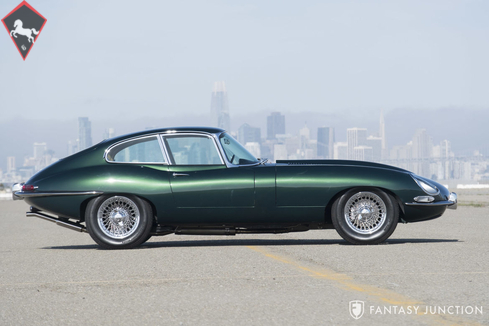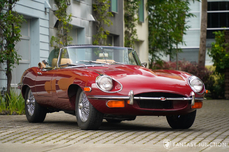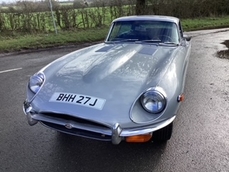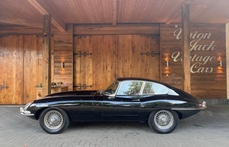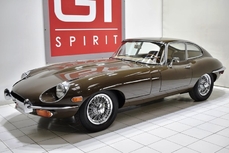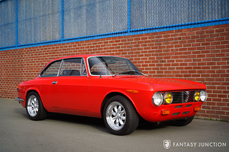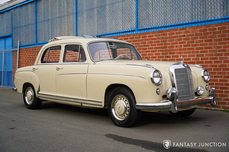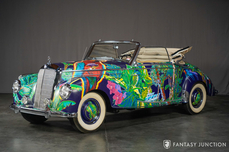Jaguar E-type 4.2Litre Inline DOHC 6-Cylinder 1965
Allgemeine Beschreibung :
1965 Jaguar XKE Coupe
Chassis Number – 1E-30249
Engine Number – 7E 1720-9
Gearbox Number – EJ 748
Body Number – 4E 20341
Exterior Color – Dark Green
Interior Color – Biscuit leather
Engine – 4.2 Liter DOHC in-line six-cylinder engine
Gearbox – 4 speed all synchromesh manual
Current Miles – 90,496 TMU
Highlights
Very early 4.2 liter Series 1 (249th built)
Numbers matching engine, head, and gearbox
Jaguar Heritage Trust Certificate
High level driver quality coupe with excellent mechanicals
January 2021 compression check 1-180, 2-170, 3-165, 4-160, 5-165, 6-170
Copies of photographs documenting restoration and upgrades
General History
Unveiled at the 1961 Geneva Motor Show, the Jaguar E-type changed everything in the sports car world. Stunning design, unrivaled performance, and racing lineage made the E-Type an immediate sensation. With its beautiful lines and surprisingly affordable price, the E-Type grew to iconic status where it has remained for more than half a century adored by collectors and enthusiasts. Independent front and rear suspension, disc brakes all around (inboard at the rear to reduce unsprung weight), and Jaguar’s legendary twin-cam inline six-cylinder engine were just part of the allure. Sales were brisk with continuous development growing in both American and European markets. Continuing sales would advance into the 1970s, but enthusiasts still remain steadfast regarding their admiration for the Series 1 models as one of the most beautiful and capable sports cars ever conceived.
Current Condition and Ownership
The current owner purchased this car in 2008 and began a three-year restoration with a focus on building a driver’s car that would reflect original appearance but host important upgrades. During the restoration, the body was stripped of mechanical systems, glass, and interior trim. A few areas of corrosion were noted during body preparation, which were treated and welded, primed, and painted. No indication of collision damage was noted during the renovation. The exterior and engine compartment were resprayed with a modern Jaguar color similar to original dark Opalescent Green. Stainless-steel bumpers and overriders replaced the corroded steel OE units. In 2016, the interior was completely refitted with new bolsters, Biscuit leather seat coverings, and finished with Biscuit trim, new headliner and wool carpets. Three-point tan seat belts were installed in 2020. The original steering wheel was replaced with a new 16” original-style wheel. All gauges are functional, including a recently rebuilt clock nested in the tachometer.
Mechanical Restoration
During the restoration, the entire drivetrain was removed from the car. The gearbox and differential were drained, inspected, and refilled with Redline synthetic lubricants. The engine was cleaned, expansion plugs replaced, and repainted. The sump was removed and cleaned. The main and rod bearing clearances were checked and found to be within tolerances, so the engine only required refreshing. A new clutch plate, disc, and throw-out bearing was fitted. New timing chains and tensioners were also fitted. A 2-inch stainless-steel exhaust system from Classicfabs in Scotland was fitted. A one-wire Delco alternator replaced the OE Lucas unit. Valvoline VR-1 20-50 weight motor oil has been used exclusively during the current owner’s stewardship. Upgrades included stainless-steel tubing for all fuel, brake, and coolant systems, a front caliper upgrade, chrome finish and stainless-steel spoked wheels, electric coolant fan, and new three-point safety belts. The fuel tank was removed and cleaned, and the interior and exterior coated with POR products. A new electronic SU fuel pump, new filter element, and level sending unit were installed. All flexible fuel lines were replaced with ethanol-tolerant hoses.
Addressing the cooling system, the original radiator was re-cored with an extra row added to improve cooling. A pressurized Series II catch tank was added to the system to recover coolant expansion. Coolant piping was replaced with stainless-steel tubing throughout, and flexible hoses were replaced with black silicone, fabricated to replicate the appearance of the fabric-wrapped hoses of the era. A new Revo-Tech puller-type electric fan with an adjustable temperature switch was also installed.
The front and rear suspension were removed and completely disassembled, media blasted, primed, painted or powder-coated, and reassembled with new bearings, bushings, and universal joints. The OE corroded chrome wire wheels were replaced with Dayton 15” x 6” chrome tubeless wire wheels with stainless-steel spokes, new knock-on spinners, and fitted with new BF Goodrich Traction TA P205/70 R15 tires.
A new clutch master cylinder and slave cylinder were installed with a stainless-steel hard line, and a stainless-steel braided flex hose. The brake system was rebuilt with new stainless steel hard lines throughout and included a new master cylinder and servo. Front and rear rotors were replaced with OE or Brembo discs. The OE front calipers were replaced with new Wilwood 128-1628 four-piston alloy calipers, with safety-wired adapters. The OE 2.125” front Dunlop brake cylinders were rebuilt by Apple Hydraulics and were then used to replace the smaller OE Dunlop rear calipers in order to maintain the braking balance of the original system. The former OE front calipers are included with the spares. Flexible brake hoses were replaced with stainless-steel braided hoses. Both brake and clutch fluids were replaced with DOT 5, an important improvement over the original hygroscopic brake and clutch system fluids. A remote bleeder system was installed on the rear calipers for easy access for bleeding of the inboard rear brakes from the left rear inner fender.
Recent Services include
A new battery was installed in 2021. The coolant system refilled with a 50/50 mix of Sierra brand non-toxic antifreeze and distilled water in 2021. Nitrophyl floats were installed during a 2020 rebuild of the SU HD8s. In 2020, the valve lash was set to 0.004” and 0.006” specifications, the timing chain adjusted, and valve stem seals added to the intake valves. A new water pump was installed, and a spin-on oil filter adapter was added.
Cosmetic presentation
The overall exterior condition boasts high gloss paint with a deep finish with a more modern pigment and metallic than originally specified. The finish shows typical areas of use including a few chips and minor stress cracks, but these are notable only upon close inspection. The lighting, lenses, and glass appear very clean and preserved throughout. The body integrity is solid overall, with good panel gaps on the hatch, and bonnet, while corner areas of the doors appear generally tight to the bodylines. The chrome window surrounds are in good original condition overall with light pitting in a few areas. The front and rear bumpers are very nice, having been replaced with new stainless-steel bumpers and overriders. The chrome wire wheels feature stainless-steel spokes are in excellent condition.
The biscuit leather interior is clean and taut with correct piping and tidy seams. Carpet and floor mats are in good condition. The black dash pad is properly contoured, and the very nicely finished instruments, switches, and other features of the interior all appear to be consistent and preserved. The interior door panels, matching covered door sills, headliner, and rear hatch area are consistent in finish and texture. The seats are comfortable and firm, having been reupholstered with fresh foam. The interior conveys an honest and harmonious look and feel very much in keeping with original specifications.
The engine compartment is correct in appearance and properly detailed as part of the recent engine refresh. The correct carburetors, complete factory air cleaner assembly, and air filter box are original, correct, and properly fit. Further components, hoses, clamps, and various hardware appear to have also been installed and detailed with originality in mind. The undercarriage appears sound and tidy, while the overall integrity of the body seams and joinery is good, and the suspension components appear properly prepared for driving use.
Included with the car
The car is accompanied by a Jaguar 4.2 E Type operating and service manual, a Retro-Sound radio manual, carpet remnant material for the interior, a convenient alloy knock off tool, a factory jack and storage bag, a set of rubber floor mats, a set of clamp-on style side view mirrors, a set of OE Dunlop brake calipers with rebuilt 1.75” cylinders, and various spare mechanical and electrical parts.
https://fantasyjunction.com/inventory/1965-jaguar-xke-fixed-head-coupe/overview
1965 Jaguar E-type 4.2Litre Inline DOHC 6-Cylinder is listed verkauft on ClassicDigest in Emeryville by Fantasy Junction for Preis nicht verfügbar.
Fakten der Auto
Karosserietyp : Auto Marke : Jaguar Modell : E-type Ausführung : 4.2Litre Inline DOHC 6-Cylinder Hubraum : 4.2 Modelljahr : 1965 Lage : Emeryville Fahrzeug Anmeldung : Normal
Verkauft
Angaben Zum Verkäufer
Verkauft
People who viewed this Jaguar E-type also viewed similar Jaguar listed at ClassicDigest
Other cars listed for sale by this dealer
über Jaguar
Ah, die Geschichte von Jaguar, von seinen Anfängen als SS Cars Ltd. bis hin zum Höhepunkt mit dem D-Typ und der Straßenversion des ikonischen E-Typs. An dieser Erzählung haftet etwas zutiefst Britisches, und ich werde sie erzählen, wie es ein britischer Journalist tun würde.Die Anfänge:
Unsere Reise in die Welt von Jaguar beginnt in den 1930er Jahren, als ein Unternehmen namens SS Cars Ltd. auftauchte. Trotz des unglücklichen Zufalls ihrer Initialen, die mit den aufkommenden politischen Spannungen in Europa zusammenfielen, begannen sie, stilvolle und leistungsorientierte Autos herzustellen. Der SS 100, der 1936 eingeführt wurde, war ein Symbol für Eleganz und Geschwindigkeit und legte den Grundstein für das, was Jaguar werden sollte.
Die Geburt von Jaguar:
Als der Schatten des Zweiten Weltkriegs näher rückte, entschied sich SS Cars Ltd. klugerweise, sich von den SS-Initialen zu distanzieren. So wurden sie 1945 offiziell zu Jaguar Cars Ltd., ein Name, der bald für britischen Luxus und Leistung stehen würde.
Die XK-Serie:
Die Nachkriegszeit von Jaguar brachte uns den XK 120, eine wahre Sensation im Jahr 1948. Mit seinem schlanken Design und einem leistungsstarken 3,4-Liter-Sechszylindermotor wurde er zum schnellsten Serienauto der Welt. Der XK 120 war die Blaupause für das, was kommen würde - Jaguars, die Stil mit Geschwindigkeit auf einzigartig britische Weise verbanden.
Die Dominanz des D-Typs:
Dann kam der D-Typ, eine wahre Rennlegende. 1954 eingeführt, gewann er in den 1950er Jahren dreimal Le Mans und zeigte die technische Kompetenz von Jaguar. Mit seiner innovativen Monocoque-Konstruktion und der ikonischen Finne hinten war der D-Typ der Höhepunkt von Jaguars Motorsporterfolgen.
Das Auftauchen des E-Typs:
Aber der wahre Wendepunkt kam 1961 mit der Einführung des E-Typs, oft von Enzo Ferrari als "das schönste Auto, das je gebaut wurde" bezeichnet. Seine lange Motorhaube, die geschwungene Karosserie und ein 3,8-Liter-Motor, der atemberaubende Leistung lieferte, machten ihn sofort zu einem Klassiker. Der E-Typ war nicht nur ein Auto; er war ein Kunstwerk auf Rädern und konnte auf der Straße 150 Meilen pro Stunde erreichen.
Straßen- und Rennsporterfolge:
Die Schönheit des E-Typs wurde durch seine Leistung auf der Rennstrecke unterstrichen. Die leichten E-Typen waren bei verschiedenen Rennveranstaltungen besonders erfolgreich und festigten den Ruf von Jaguar als eine Kraft, mit der man im Motorsport rechnen musste.
Das Zeitalter der Raffinesse:
Je tiefer wir in die Geschichte von Jaguar eintauchen, desto mehr erkennen wir, dass die 1950er und 1960er Jahre ein Zeitalter der Raffinesse und Expansion waren. Neben dem großartigen D-Typ und dem ikonischen Aufstieg des E-Typs führte Jaguar Modelle ein, die seinen Ruf für Luxus und Leistung weiter festigten.
Der MK2:
Ende der 1950er Jahre stellte Jaguar den MK2 vor, eine Sportlimousine, die Eleganz mit Leistung vereinte. Diese elegante viertürige Limousine war sowohl bei Bankräubern als auch bei der Polizei aufgrund ihrer außergewöhnlichen Geschwindigkeit und Handhabung beliebt. Der MK2 war ein Symbol für Jaguars Fähigkeit, Raffinesse mit Leistung zu verbinden und hatte auch eine erfolgreiche Rennkarriere.
Der XJ6:
Springen wir ins Jahr 1968, als Jaguar ein Auto auf den Markt brachte, das Jahrzehnte lang Luxuslimousinen definieren würde - den XJ6. Es war ein Meisterwerk der Ingenieurkunst und des Designs, mit einem sanften Reihensechszylindermotor, unabhängiger Hinterachse und einem geräumigen, wunderschön ausgestatteten Innenraum. Der XJ6 war ein Symbol britischer Eleganz und bot eine so sanfte Fahrt, dass es schien, als würde er förmlich über die Straße gleiten. Er wurde zum Flaggschiffmodell für Jaguar und setzte den Maßstab für Luxuslimousinen und zeigte ein Maß an Raffinesse, das die Konkurrenz staunen ließ.
Die Verschmelzung von Klassik und Moderne:
Während der MK2 und der XJ6 die Evolution der Limousinen von Jaguar repräsentierten, bewahrten sie das Engagement der Marke für Leistung und Luxus. Diese Autos gehörten nicht nur auf die Rennstrecke; sie fühlten sich genauso wohl auf den Prachtstraßen wie auf einer entspannten Fahrt durch die englische Landschaft.
Die Herausforderungen des Wandels:
Dennoch sah sich Jaguar mit dem Eintritt der 1970er Jahre, wie viele britische Automobilhersteller, finanziellen Herausforderungen und Veränderungen in der Eigentümerschaft gegenüber. Die Ära von British Leyland brachte sowohl Chancen als auch Schwierigkeiten mit sich, während die Marke durch verschiedene Fusionen und Übergänge navigierte.
Das Erbe des MK2 und des XJ6, zusammen mit dem D-Typ und dem E-Typ, definiert Jaguar weiterhin als einen Hersteller, der zeitlose Eleganz mit einer Leistungsstärke vereint. Diese klassischen Modelle, ob sie über kurvige Straßen gefahren oder als Sammlerschätze geparkt werden, dienen als Zeugnis für die anhaltende Präsenz von Jaguar in der Welt der automobilen Exzellenz.
Die Jaguar-Geschichte, von ihren Anfängen als SS Cars Ltd. bis zur Schaffung von Automobilikonen wie dem E-Typ, dem MK2 und dem XJ6, ist eine Reise, die das Wesen des britischen Automobilbaus widerspiegelt - eine Mischung aus Luxus, Leistung und Stil, die nach wie vor Enthusiasten und Kenner gleichermaßen fasziniert.
